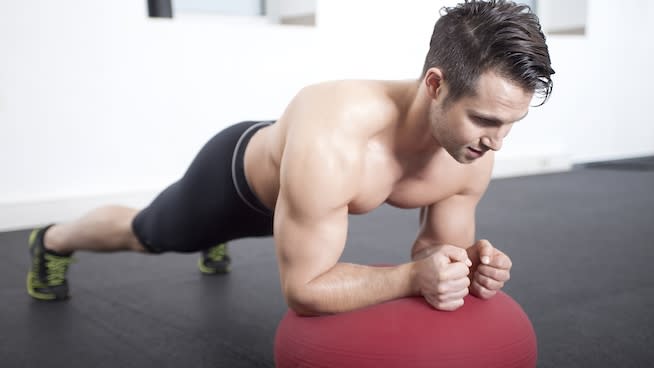Planking Gone Wrong: Core Training that Can Hurt Your Athletic Potential

Most athletes now know that core training with planking exercises can improve athletic performance, and many have added it to their routines with the hopes of a great return on their investment. Sounds like success, right?
The unfortunate reality of life is that good intentions don't always guarantee good results. For example, lifting heavy weights to get stronger is a good idea, but it doesn't mean doing high-speed micro-shrugs with 100-pound dumbbells will build your traps.
Core training is no different. The general rule states, "precision pays and sloppy stays." As one of my professors used to say, "practice makes permanent, not perfect."
RELATED: The 3 B's of Smarter Core Training
Doing a plank with improper form (the saggy plank) is the most common core training mistake. It gets in the way of spinal stability and a strong deep core. The hips sag to the floor, the low back is fully arched, knees are bent, shoulders are up by the ears, and the head is tilted up.
Doing planking exercises and associated variations this way will cause you to miss out on several key benefits. Bracing your core while maintaining a neutral spine is the best way to activate the internal obliques and overall core, compared to hollowing, non-activation and dynamic flexion/extension exercises. Also, contraction of the glutes and core have been shown to correct excessive anterior pelvic tilt and stabilize the spine in a neutral position, which is ideal for muscular co-contraction. This is favorable for avoiding excessive arching and possible injury.
Further, research has found that activation of the gluteal and deltoid muscles during core strength work is optimal for increasing core strength.
Follow these tips for a better plank and you will feel the difference.
Set Up
Your starting position sets the tone. Put a broomstick on your back and prop your body onto your forearms and toes. Look in the mirror. The back of your head, upper back and tailbone should be contacting the stick, with not quite enough space for a hand to fit between the stick and the low back.
Visualize one string attached to the top of your head and one to your tailbone. They are pulling your spine in opposite directions, making it as long as possible.
RELATED: STACK Challenge: Timed Plank
Execution
Be active in the position. Find the burn; Don't wait for it to find you. Brace your abs like a shield or brick wall as if someone were about to punch you in the stomach. Dig your elbows into the floor, set your shoulders away from your ears, and try to move the floor back toward your hips.
If your low back looks like a ski jump in this position, squeeze your glutes hard and keep the contraction. Your abs will burn. If you can't maintain the contraction, you need to try an easier version—like elbows on a bench—and work back up.
Takeaway
One minute of incorrect technique is less beneficial than 20 seconds of precise form with full focus and effort.
Try adding 5 to 10 seconds to this exercise every workout and you will get more from your minute Plank when it happens.
Bonus
Once you've mastered these basic elements of the Plank, the possibilities for progression and improvement are limitless. Check out the video above for 17 ways to apply this theory to your advantage in the gym.
References:
1. Baerga-Varela L, Abréu Ramos AM. "Core strengthening exercises for low back pain." Bol Asoc Med P R. 2006 Jan-Mar;98(1):56-61. Review. PubMed PMID: 19610550.
2. Boren K, Conrey C, Le Coguic J, Paprocki L, Voight M, Robinson TK. "Electromyographic analysis of gluteus medius and gluteus maximus during rehabilitation exercises." Int J Sports Phys Ther. 2011 Sep;6(3):206-23. PubMedPMID: 22034614; PubMed Central PMCID: PMC3201064.
3. Gottschall JS, Mills J, Hastings B. "Integration core exercises elicit greater muscle activation than isolation exercises." J Strength Cond Res. 2013Mar;27(3):590-6. doi: 10.1519/JSC.0b013e31825c2cc7. PubMed PMID: 22580983.
4. Koh HW, Cho SH, Kim CY. "Comparison of the Effects of Hollowing and BracingExercises on Cross-sectional Areas of Abdominal Muscles in Middle-aged Women." JPhys Ther Sci. 2014 Feb;26(2):295-9. doi: 10.1589/jpts.26.295. Epub 2014 Feb 28. PubMed PMID: 24648652; PubMed Central PMCID: PMC3944309.
5. Leetun DT, Ireland ML, Willson JD, Ballantyne BT, Davis IM. "Core stabilitymeasures as risk factors for lower extremity injury in athletes." Med Sci SportsExerc. 2004 Jun;36(6):926-34. PubMed PMID: 15179160.
6. Maeo S, Takahashi T, Takai Y, Kanehisa H. "Trunk muscle activities during abdominal bracing: comparison among muscles and exercises." J Sports Sci Med. 2013Sep 1;12(3):467-74. eCollection 2013. PubMed PMID: 24149153; PubMed CentralPMCID: PMC3772590.
7. Watanabe S, Eguchi A, Kobara K, Ishida H. "Influence of trunk muscleco-contraction on spinal curvature during sitting, reclining against the backrest of a chair." Electromyogr Clin Neurophysiol. 2008 Nov-Dec;48(8):359-65. PubMedPMID: 19097476.
This article originally appeared on STACK.com: Planking Gone Wrong: Core Training that Can Hurt Your Athletic Potential

